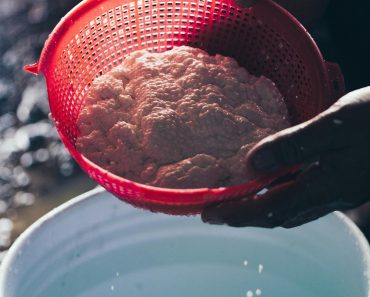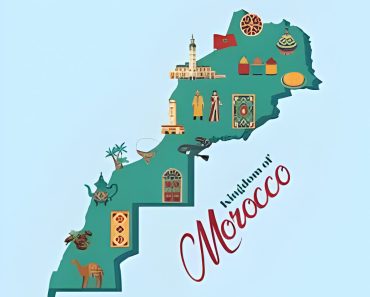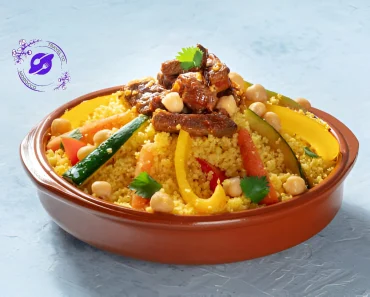Decoding Moroccan Mesmen: A Culinary Journey Through Morocco’s Iconic Dish
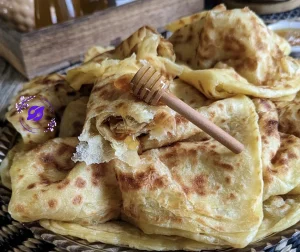
Maroccan Mesmen
Unveiling Mesmen: A Moroccan Culinary Treasure
Moroccan Mesmen, also known as “Rghaif” in some regions, is a traditional Moroccan flatbread that holds a special place in the hearts and palates of Moroccans. What sets mesmen apart is its delicate, layered texture achieved through a meticulous folding and stretching technique during the preparation process. This results in a flaky, buttery pastry that is both versatile and delectable.
Characteristics of Moroccan Mesmen
- Texture: Mesmen is characterized by its thin, yet multi-layered texture. When cooked to perfection, it should have crispy, golden-brown outer layers with soft, slightly chewy interiors.
- Flavor Profile: The flavor of mesmen is a harmonious blend of savory and buttery notes, often enhanced by the use of aromatic spices such as cumin and sesame seeds.
- Versatility: While mesmen can be enjoyed on its own as a snack or light meal, it is also commonly served alongside savory dishes such as tagines, stews, or with sweet accompaniments like honey or jam.
- Cultural Significance: Mesmen is deeply rooted in Moroccan culture and is often prepared during festive occasions, family gatherings, and celebrations, symbolizing warmth, hospitality, and togetherness.
Key Ingredients of Maroccan Mesmen
To create authentic Moroccan mesmen, several key ingredients are essential:
- Flour: High-quality all-purpose flour forms the base of mesmen dough, providing structure and texture.
- Semolina: Adding semolina flour adds a subtle crunch and enhances the overall texture of the mesmen.
- Yeast: Active dry yeast or instant yeast is used to leaven the dough, allowing it to rise and develop a light, airy consistency.
- Salt: A pinch of salt not only enhances the flavor but also helps in regulating the dough’s fermentation process.
- Water: Lukewarm water is used to activate the yeast and bring the dough together to the desired consistency.
- Butter: Unsalted butter, preferably at room temperature, is incorporated into the dough and also used for layering between the folds, contributing to the mesmen’s rich, buttery taste.
- Spices: Optional spices such as ground cumin, sesame seeds, or nigella seeds can be added to the dough for added flavor complexity.
The Art of Cooking Moroccan Mesmen : Step-by-Step Guide
Now, let’s unravel the mystery behind creating perfect mesmen at home. Follow these steps for a delightful culinary experience:
Step 1: Prepare the Dough
- In a large mixing bowl, combine the all-purpose flour, semolina flour, salt, and optional spices (if using).
- Dissolve the yeast in lukewarm water and let it sit for a few minutes until frothy.
-
- Divide the dough into equal-sized balls and let them rest, covered, for about 30 minutes to allow for fermentation.
Step 2: Roll and Layer the Dough
- Take one dough ball and roll it out into a thin circle on a lightly floured surface.
- Spread a thin layer of softened butter over the rolled-out dough.
- Fold the dough into thirds, like folding a letter, to create layers.
- Repeat the rolling, buttering, and folding process two more times, ensuring even layers of butter between each fold.
- Let the layered dough rest for another 15-20 minutes.
Step 3: Shape and Cook Maroccan Mesmen
- After resting, roll out the layered dough into a larger circle, about 1/8 to 1/4 inch thick.
-
- Carefully transfer the rolled-out dough to the heated pan and cook for 2-3 minutes on each side or until golden brown and crispy.
- Brush each side with a little more butter while cooking for added flavor and moisture.
- Once cooked, remove the mesmen from the pan and place it on a wire rack to cool slightly before serving.
Step 4: Serving Suggestions
Mesmen can be served warm or at room temperature, depending on personal preference. Here are some delightful serving suggestions:
- Savory Pairings: Serve mesmen alongside Moroccan tagines, grilled meats, or as a base for flavorful fillings such as spiced vegetables or cheese.
- Sweet Variations: For a sweet treat, drizzle warm mesmen with honey or spread it with fig or apricot jam.
- Tea Time Delights: Mesmen makes a delightful accompaniment to traditional Moroccan mint tea, creating a perfect balance of flavors.
Eating in a way that’s rich in Moroccan cuisine can include dishes like tagines, couscous, and pastries that are flavorful and often hearty. To lean into the “fattening” side of things (which can be a matter of preference or need), you might focus on dishes that use generous amounts of ingredients like olive oil, nuts, and meats. Here’s how you can approach it:
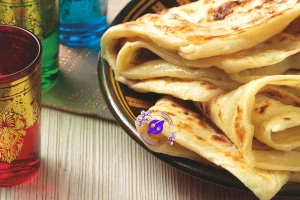
Moroccan Mesmen
- Olive Oil: Use liberal amounts of olive oil in your cooking. Moroccan cuisine often relies on olive oil for its rich flavor and health benefits. You can drizzle it over salads, use it for sautéing vegetables, or in the preparation of tagines and couscous.
- Nuts and Seeds: Incorporate plenty of nuts and seeds into your meals. Almonds, walnuts, and sesame seeds are commonly used in Moroccan dishes. They add a satisfying crunch and contribute healthy fats.
- Meats and Protein: Include protein-rich foods like lamb, chicken, and fish in your meals. These proteins can be cooked in flavorful sauces and spices to enhance their taste.
- Dried Fruits: Dried fruits like apricots, dates, and figs are often used in Moroccan cooking to add sweetness and texture to dishes. They are a good source of natural sugars and can contribute to a more satisfying meal.
- Pastries and Sweets: Enjoy Moroccan pastries and sweets in moderation. Treats like baklava, ma’amoul, and chebakia are indulgent and can be part of a fattier meal plan if balanced with other nutritious foods.
- Balanced Portions: While indulging in richer foods, ensure you balance your meals with plenty of vegetables, legumes, and whole grains. This helps provide essential nutrients, fiber, and keeps the overall meal balanced.
- Traditional Beverages: Explore traditional Moroccan beverages like mint Tea or avocado smoothies. These can complement your meals and add variety to your dining experience.
Remember, enjoying fattier foods can be part of a balanced diet when combined with mindful portion control and a variety of nutrient-dense foods.
A Culinary Tour of Moroccan Cities
Morocco’s culinary landscape is as diverse as its geographical terrain, with each region offering unique flavors and specialties. Let’s take a culinary tour of some of Morocco’s most famous cities and discover their culinary contributions:
1. Marrakech
Known for its bustling souks and vibrant street food scene, Marrakech is a food lover’s paradise. Here, you’ll find tantalizing dishes such as lamb tagine with prunes, couscous royale, and fragrant pastries like almond-filled briouats.
2. Fez
Fez is synonymous with traditional Moroccan cuisine, including the famed pastilla, a savory pastry filled with spiced meat and topped with powdered sugar and cinnamon. The city also boasts a variety of aromatic spice blends and artisanal breads like khobz, perfect for savoring with mesmen.
3. Casablanca
As Morocco’s economic hub, Casablanca offers a fusion of traditional and modern culinary delights. Indulge in fresh seafood dishes, such as grilled sardines or seafood pastillas, accompanied by mesmen for a satisfying meal by the sea.
4. Chefchaouen
Nestled in the Rif Mountains, Chefchaouen is renowned for its blue-hued streets and vibrant food culture. Sample local specialties like ras el hanout-spiced lamb, vegetable tajines, and of course, freshly baked mesmen from the town’s charming bakeries.
5. Essaouira
Known for its coastal charm and seafood abundance, Essaouira beckons with grilled fish platters, seafood couscous, and crispy fried calamari, all of which pair wonderfully with a side of mesmen to soak up the flavorful sauces.
Conclusion: Maroccan Mesmen Unites Morocco’s Culinary Heritage
In conclusion, Moroccan mesmen encapsulates the essence of Moroccan cuisine with its delicate layers, aromatic flavors, and cultural significance. By understanding its characteristics, key ingredients, and cooking techniques, you can embark on a culinary journey that celebrates the rich tapestry of Moroccan gastronomy. As you explore the diverse cities of Morocco, each offering its culinary treasures, remember that mesmen remains a unifying culinary delight that brings people together to savor the warmth and hospitality of Moroccan culture.
